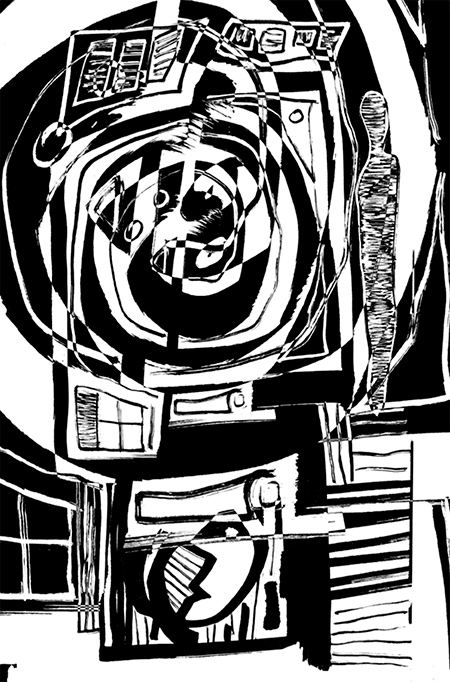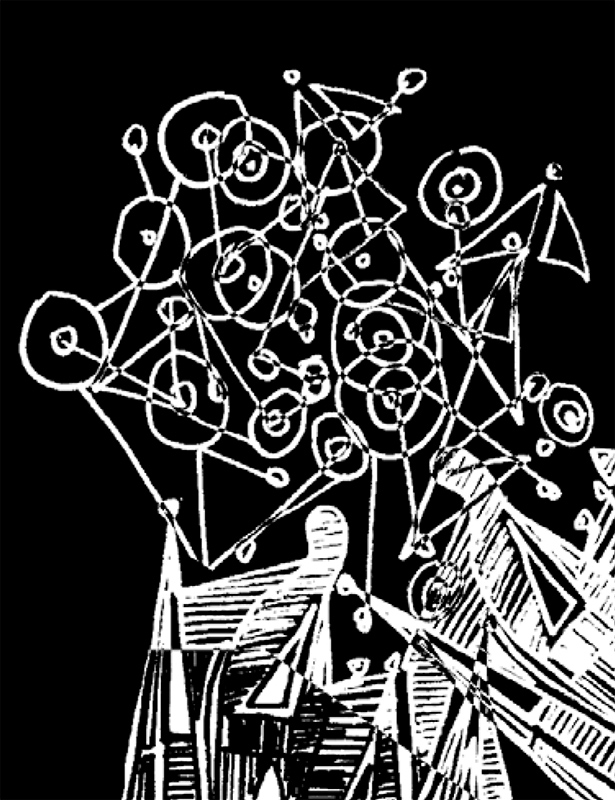Future Shock Then and Now

What Alvin Toffler’s iconic 1970 book got right, wrong, and missed about the world of 2025 and how his insights might help us better navigate the 21st Century.
This blog post was created for a presentation scheduled for mid-November 2025 at ASPEC at Eckerd College.
That puts it at the end of this year’s hurricane season. Last year at this time, the college was literally under water. The Tampa Bay had been struck by a double whammy of once-in-a-century hurricanes named Helene and Milton.
Much of my audience is in their mid 70s or older. So, between the weather and demographics, my event about the future might not have much of an in-person future.
But it will most definitely have a future online.
An Overview: Alvin Toffler and the Zeitgeist of America in the 1950s and the 1960s.
Let us start with a simple definition of “Alvin Toffler’s Future Shock” according Google AI:
Future shock is the psychological state of stress and disorientation that occurs when individuals and entire societies are overwhelmed by the rapid pace of technological and social change. Coined by futurist Alvin Toffler in his 1970 book “Future Shock”, the term describes a state of “too much change in too short a period of time”.
Here is a quick and clear executive summary of Alvin Toffler’s concept of future shock:
My YouTube algorithm showed me this video on a thought-provoking book titled “After Shock: 50 of the World’s Foremost Futurists Reflect on 50 years of Future Shock and look ahead to the Next 50.”
It was published in 2020.
Here are two important quotes about why we must think seriously and playfully about the future:
“The illiterate of the 21st century will not be those who cannot read or write, but those who cannot learn, unlearn, and relearn.”
—Herbert Gerjuoy, psychologist. This quote is mistakenly attributed to Alvin Toffler but perfectly encapsulates his thinking.
My favorite quote about our role in the future is the last paragraph from the last page of “Global Mind Change” by distinguished Stanford Research Institute futurist Willis Harman:
“We do have an advantage over every other time in history. When other profound change took place, those living through it tended to be unaware of the historical significance, and were aware mostly of the transition pain and difficulties. We are fortunate enough not only to be able to watch major change take place within a single lifetime, but also to possess enough knowledge to have a good picture of what is going on. Our part in it can be exhilarating and fun. Given the choice, why not perceive it that way?”
The two biggest misconceptions in Future Shock 1970 from the vantage point of 2025:
Toffler greatly underestimated the adaptability of both individuals and organizations to successfully adapt to rapid technological change and challenges. An example would be the astoundingly fast development and distribution of effective Covid-19 vaccines.
Another example is the ability of global financial markets to just shrug off President Trump’s draconian tariffs on our trading partners and inflationary tax cuts at home.
We need to take into account the effects of Black Swans–unforeseeable events that significantly transform systems and domains. This includes the rapid ascent of global social media and Artificial Intelligence. Another would be Israel’s ability to militarily defeat its arch enemy, Iran, in just 12 days.
Before continuing with the written content of this blog post, consider taking a quick peek at these evocative YouTube videos:
“Que Sera Sera” sung by Doris day (1956)
“1968 - Year of War, Turmoil and Beyond” | Free Documentary History
“Future Shock Documentary” (1972) narrated by Orson Wells
1990 Interview with Alvin Toffler (audio)
Some background on Toffler and his times:
Toffler’s iconic and globally influential book was first published in English in 1970. It reflected his journey as a blue collar, left-leaning, post WWII Jewish American intellectual. He was a child of immigrants from Poland. His passionately intellectual aunt and uncle lived with his family in a working class apartment in Brooklyn. They inspired him to become a writer.
Toffler was hired as a labor columnist at “Fortune Magazine” in 1959 until 1962. He was in his early thirties. This classic American magazine was owned and run with an iron hand by the powerful WASP Time-Life publishing tycoon Henry Luce.
At the time, “Fortune” expressed the Protestant elite’s deep faith in American capitalism to deliver prosperity, technological and social progress, democracy, and relative international peace .
American big business was seen a bulwark against godless Soviet totalitarianism and key to winning the “cold war”. Luce called the 20th century “The American Century”. And this sentiment was shared overwhelmingly by the Americans of both political parties.
The post-war period in America was marked by social conformity, political consensus, and an embrace of the fruits of science and technology.
Think:
American made cars and super highways, labor-saving household appliances, skyscraper office buildings, massive tract housing developments, vaccines against deadly childhood diseases especially polio, TV, super highways, government subsidized college education and home mortgages for men who served in the armed forces, and there was breathtaking vision of space exploration. But there were “snakes” in this post-war garden of Eden. The threat of nuclear annihilation was a deep-seated anxiety in the American psyche. Their pervasive American nightmare was that the Russians would do to us what we did to Hiroshima and Nagasaki.
This was augmented by images of Jewish concentration camp survivors that were featured in Luce’s Life Magazine that could be found in almost every American middle class living room after the war. This lead to a popular revulsion against Nazi fascist ideology and widespread Christian sympathy for Jews; perhaps for the first time in Jewish history.
In 1969, LIFE magazine published photos that captured the brutality and human suffering of the Vietnam War, including the My Lai massacre in 1969 and the harrowing deaths of American soldiers. The magazine’s coverage, such as the 1969 “One Week’s Toll” feature, brought the war’s realities to American homes, significantly impacting public opinion and the perception of the conflict.
Perhaps of even greater importance were the television images of the war. The anti-war protests were mostly a college kid’s and old lefty thing; then it became more mainstream.
Walter Cronkite traveled to Vietnam in early 1968, coinciding with the Tet Offensive. His subsequent broadcast on February 27, 1968 is a landmark moment in Vietnam War reporting, where he famously declared the conflict was a stalemate. His report, broadcast nationally on CBS News, broke with traditional journalistic impartiality by offering his personal conviction that the war was unwinnable and that negotiations were the only rational way out.
This commentary, from “America’s most trusted man,” significantly influenced public opinion, contributing to widespread skepticism of official government narratives and the growing anti-war sentiment in the United States.
Future Shock expressed the alarm and confusion of America’s rapid transition from post WWII victory and world dominance to a present moment of great national uncertainty, and social and psychological chaos.
Things really came to a head and blew up in 1968.
There was the civil rights movement, anti-war movement, the feminist movement, the sexual revolution and birth control pill sex-drugs-rock n roll, and Richard Nixon.
But, perhaps most mind altering was Neil Armstrong’s July 20, 1969 moon walk.
As the deeply perceptive American writer, social critic, and longshoreman, Eric Hofer wrote in his seminal 1967 book “The Temper of Our Times”:
“Every great cause begins as a movement, becomes a business, and eventually degenerates into a racket”
Perhaps this helps to explain the political and cultural ascent of Donald Trump and the radical populist Make America Great Again movement.
Personal Thoughts about the current global malaise and the future
The big change in my lifetime from growing up in Chicagoland in the 1950s and early 1960s to my life in St. Pete in 2025 is that as a child and teenager the future looked bright, prosperous, and that the 20th century was the “American Century.”
American society really started to change for the worse with the assignations of JFK in 1963, MLK in 1968, and RFK also in 1968. Had these three celebrated American leaders survived their shootings, it is quite possible that our country would have remained relatively cohesive and stable. And the paralyzing political and cultural polarization would simply not lead to the current national gridlock.
Since the end of the tragic, divisive, and disastrous Viet Nam war in 1973, our country has experienced a general malaise and funk, punctuated by a few moments of national hope for a better future.
For me, this includes Americans on the moon; the election and first term of Ronald Reagan; the election and first term of Barak Obama; and Elon Musk’s SpaceX catch of a super-heavy rocket booster on its return to Earth from the edge of space.
The influential and acerbic author, and successful mathematical options trader, Nassim Taleb, said that one must have “skin in the game”–meaning money–when making predictions. Otherwise it is just sound and fury signifying nothing.
Here is what I think allocations that will both survive and thrive in the world of the 2080s:
55% Total US Stock Market Index; 30% Total International Stock Index ex U.S.; 10% NASDAQ 100; 5% Bitcoin and Crypto.
My reasoning and imaginings will be the subject of another blog post. But I must laugh at my tremendous expenditure or time and mental energy in trying to forecast the ultimate movements of financial markets.
In another generation or two, the U.S. might have a staunchly socialist government that taxes away the generational transfer of wealth. Conversely, everyone will have their very own super genius AI personal assistant that will provide each citizen with fast and easy money off the global financial markets.
That is the perennial human dilemma in a nutshell:
None of us will ever have enough information or foresight to accurately forecast our future or that of our loved ones.
Que sera sera.
American Culture around 1970
Top 10 Pop Tunes
-
“Bridge Over Troubled Water” by Simon & Garfunkel
- “(They Long to Be) Close to You” by The Carpenters
- “American Woman” by The Guess Who
- “Raindrops Keep Fallin’ on My Head” by B.J. Thomas
- “War” by Edwin Starr
- “Ain’t No Mountain High Enough” by Diana Ross
- “I’ll Be There” by The Jackson 5
- “Get Ready” by Rare Earth
- “Let It Be” by The Beatles
- “Band of Gold” by Freda Payne
Notable nonfiction bestsellers in 1970 included:
- “Future Shock” by Alvin Toffler
- “Everything You Always Wanted to Know About Sex (But Were Afraid to Ask)” by David Reuben
- The American Heritage Dictionary of the English Language
The following movies were nominated for an Oscar at the 42nd Academy Awards in 1970. The awards celebrated the best films of 1969.Best Picture nominees:
- “Midnight Cowboy” (Winner)
- “Anne of the Thousand Days”
- “Butch Cassidy and the Sundance Kid”
- “Hello, Dolly!”
- “Z”
Bob’s List of Notable Cultural Stuff around 1970
“The Whole Earth Catalog” was highly influential in the 1970s as it was a bestseller that provided a resource for the counterculture, environmental movement, and back-to-the-land ethos. Published in the early 1970s, it offered practical information and reviews of tools, books, and ideas for self-sufficiency and ecological awareness, becoming a model for the future internet and a vital part of the broader ecological and cyber-cultural movements.
Artist Peter Max was very big and ubiquitous in 1970, known for his prominent role in the counterculture and Pop Art movements, with his vibrant, psychedelic art appearing on everything from magazine covers and posters to consumer products, advertising, and even city buses and the New York Yellow Pages. His commercially successful and recognizable work made him a pop culture icon associated with the spirit of the era
Ram Dass (aka Richard Alpert) and Timothy Leary were “big” in the context of the 1970s counterculture movement, with Leary still a prominent, though controversial, figure and Ram Dass becoming a major spiritual teacher who wrote about his experiences and founded organizations dedicated to spiritual well-being and social service.
In 1970, President Nixon authorized U.S. and South Vietnamese forces to invade Cambodia to attack communist supply bases, sparking widespread anti-war protests in America, including the deadly Kent State and Jackson State shootings. Despite the U.S. troop withdrawal from Cambodia by June, the conflict expanded, as did the influence of the Khmer Rouge.
The war also continued to be fought in Vietnam, as the ongoing “Vietnamization” policy aimed to shift combat to South Vietnamese forces while the U.S. provided support.
America’s top sports heroes in the 1970s included boxing icon Muhammad Ali, swimmer Mark Spitz, football star O.J. Simpson, and tennis champion Billie Jean King. Other notable athletes included NFL quarterback Terry Bradshaw. running back Earl Campbell, and Olympic decathlete Bruce Jenner.
The Human Potential Movement was highly influential in the 1970s, becoming a widespread cultural trend that promoted personal authenticity, self-actualization, and human autonomy through new psychological approaches and practices. Its ideas spread through growth centers like the Esalen Institute counter groups and best-selling books, and it popularized concepts like meditation, yoga, and personal development that significantly impacted mainstream culture.
The sexual revolution was a very big deal in the 1970s, continuing and intensifying the changes in attitudes towards sex and sexuality that began in the 1960s. The 1970s saw increased openness about sex, the rise of women’s and gay liberation movements, greater access to birth control and abortion, and a significant shift in social norms around relationships and premarital sex.
Books about the dynamics of societal and global change that deeply affected my life choices and outlook as both a young and old man:
- “The Human Use of Human Beings” by Norbert Wiener 1950
- “Thinking about the Unthinkable” by Herman Kahn 1962
- “The Age of Discontinuity” by Peter Drucker 1969
- “Global Mind Change” by Willis Harman 1988
- “The Protean Self” by Robert Jay Lifton 1995
- “The Drunkard’s Walk” by Leonard Mlodinow 2008













